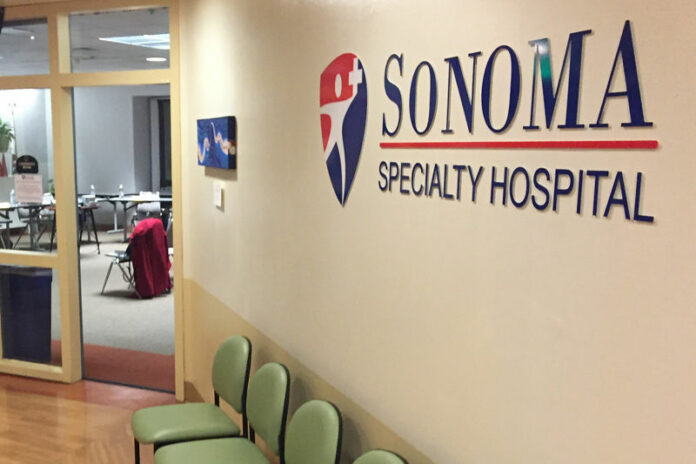Now that it no longer owns the hospital, what should happen to the Palm Drive Health Care District? The answer to that question depends on who you ask.
Residents of west county pay between $105 to $155 in parcel taxes every year to the Palm Drive Health Care District, a special district that was formed in 2000 to ensure the survival of what used to be known as Palm Drive Hospital.
Now that the district has sold the hospital to a private company, it might seem obvious that the district’s mandate is at an end, but nothing is obvious — or uncontested — in the ongoing saga that is the Palm Drive Health Care District.
The question of what comes next for the district — dissolution or a new chapter as a different kind of health care provider — has pit district stalwarts, who want to see the district continue, against board newcomer Richard Power, who seems to have taken on Jim Horn’s old role as the board’s resident skeptic. (Horn, who used his position on the board to wage a one-man war for transparency, resigned from the board in May of this year.)
Power is adamant that, now that the hospital has sold, it is time for the district to dissolve.
“I am following every path that has possibilities leading to dissolution for the district,” Power said. “I ran on that ticket, and I’m going to stay on it.”
It is important to note that whether the district dissolves or not, residents of west county, including those in detached areas, will have to continue paying the parcel tax for for approximately 14 more years.
The argument for dissolution
According to Power, the language of Measure W, the 2004 parcel tax measure which funded the district, was quite clear: the district was created to support the hospital, the emergency room and related medical personnel. (See sidebar in this article on sonomawest.com.) Now that the emergency room has been closed (replaced by an urgent care) and the hospital has been sold, Power believes the district’s reason for existence is over, and that it would be outside the district’s mandate to fund other health care programs other than the hospital.
Earlier this year, the district board requested an outside legal opinion about how narrowly or broadly Measure W can be construed. The San Francisco law firm of Hanson Bridgett is preparing an opinion and has promised to deliver it by the end of the year.
And then, according to Power, there’s the money: The district collects over $3 million a year in parcel taxes, but the vast majority of that is now devoted to bankruptcy payments and bond repayment, leaving only about $700,000. Of that $700,000, district operating expenses for administrative salaries and legal fees eat up another $400,000-500,000, leaving just $200,000 to spend on other health care-related programs, which according to Power, they shouldn’t be spending the money on anyway.
“The question is, does it make sense to spend $400,000 to $500,000 in overhead to give away $200,000? I don’t think it does,” he said.
The return of Dan Smith
Power has a surprising supporter in his fight to end the district: Dan Smith, the man who led the charge to save the hospital and create the district in the first place back in the early 2000s.
Smith partnered with board president Dennis Colthurst in a run against Power in the board election in November 2018. In that three-way race for two seats on the board, Power and Colthurst won, and Smith lost.
According to statements he made during the campaign, Smith shares Power’s conviction that the district should be dissolved once the hospital has been sold.
According to candidate filing documents at the Sonoma County Voter Registrar’s office, Smith stated, “Having completed this transition, the district will have served its purpose and should reduce its overhead, settle its bankruptcy and focus on repayment of the bond. Once this has been accomplished, I will support transferring the district to the county for completion of bond repayment to further reduce expenses.”
At Power’s urging, Smith appeared and spoke at a recent Local Agency Formation Commission (LAFCO) meeting and expressed this same opinion.
“From my perspective, jaws dropped when he walked up,” said Power. (Sonoma West attempted to contact Smith for a comment, but he didn’t return our call.)
Power’s passion for dissolving the district, however, puts him in the minority on the Palm Drive Health Care District board.
“There have been indications from at least two board members that they think it should stay open and that we have the right to spend the excess money on what I’m going to call more public health sort of initiatives,” Power said.
And still I rise
Board member and longtime district advocate Gail Thomas is one of those who think Palm Drive Health Care District has a future and an important role to play in medical care in west county.
“I firmly believe that the district has a role it can play, but I also believe in democracy and I think the community has to decide whether that’s a role they want to support,” Thomas said.
Thomas said the board has formed an ad hoc committee to explore possible futures for the health care district. The board includes Thomas, board member Eira Klich-Heartt, several local physicians, Sebastopol’s former chief of police Jeff Weaver and others.
Thomas said thus far the committee has come up with at least two ways the district could continue to contribute to the health of west county: one would be to subsidize longer hours for the urgent care, which is currently only open 9 a.m. to 9 p.m., and the other would be to have a mobile health clinic deliver care to the far-flung regions of west county.
“The biggest thing this community has always wanted is the emergency room,” Thomas said. “I think that if we have a 24-7 high-level urgent care — which has its own lab and imaging and the operating rooms should be opening shortly — that we then can be doing almost exactly what we did before, because, as an emergency room, 90% of it was urgent care.”
Thomas said the ad hoc committee is exploring whether the district “can help subsidize that for the community so community residents could go to the urgent care and pay a very minor co-pay like $5, and their insurance company would pay whatever they don’t pay and the district will pick up the rest. We’ve penciled that out and that looks like something we could do,” she said, noting that this potential program would only apply to residents of the district.
“Another thing we’re looking at is a telemedicine mobile unit that would be able to go all the way up the coast … these people are underserved and they’re hugely deprived of medical services because they’re an hour or more away from anything,” she said.
Thomas said the district would subsidize the cost for mobile health care for people who are within the boundaries of the health care district. Those outside the district (including those in the detached areas) would have to pay the full cost of treatment, but at least there would be health care available to them, Thomas said.
Sunrise, sunset
Thomas is hoping that the district will do what it has always done in times of trouble in the past: turn to the community. She wants a chance to lay out the ad hoc committee’s new vision for how the district can continue to support health care in west county. She also said that the committee’s work has really just begun and that they are looking for more community members to help them define what the future of the district might be. (The next meeting is in early January. Contact the PDHCD for more information.)
“I want to hold some town hall meetings in February, and present some of the ideas the committee has come up with to the community and also to ask, ‘What would you like us to be doing?’” said Thomas.
Like Thomas, Power is eagerly awaiting the legal opinion from Hanson Bridgett regarding whether the district has the ability to pursue broader programs. He hopes the answer will be no, but isn’t making bets either way.
In the meantime, he said he is looking into a variety of approaches to dissolve the district:
1) The district could vote to dissolve itself. Power said how this idea “is received by the other directors will, in part, be a function of what results we get on the restrictions on the use of the Measure W money” in the Hanson Bridgett report.
2) LAFCO, determining that the district’s job is over now the hospital has been sold, could decide to simply dissolve the district.
3) Residents of the district can start a petition drive to dissolve the district. To do this, they must gather a number of signatures equal to at least 10% of the registered voters in the district. (If this seems like a low bar, remember that the petition to create the district likewise had a low bar: it had to have a number of signatures equal to 12% of registered voters.)
4) Dissolution by continued detachments. The Russian River and Bodega areas have already detached, depriving the district of 40% of its original parcels. Other areas might choose to detach in the future. This is the option that Power described as “the death by a thousand cuts.”
5) The final route to dissolving the district is the electoral process.
“Another option is to locate and support candidates for at least two of the three open seats a year from now, for a campaign based on dissolving the district,” Power said. The three candidates up for election in 2020 include district advocates Gail Thomas, Eira Klich-Heartt and Randy Coffman.
This latter scenario would make for lively, hotly contested election, but that’s par for the course for Palm Drive Health Care District board, west county’s most durable never-ending story.
53.6
F
Healdsburg
December 28, 2024








